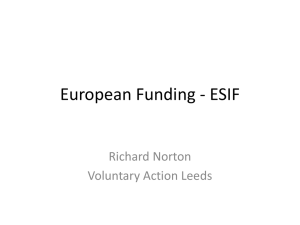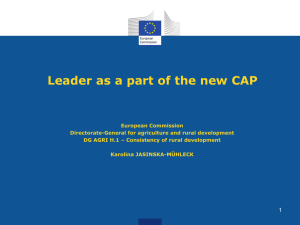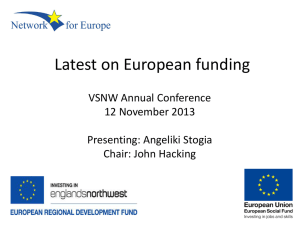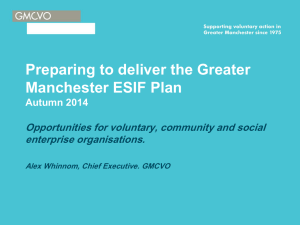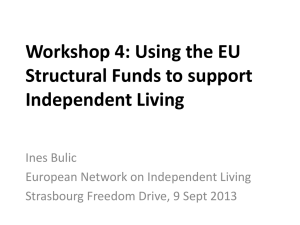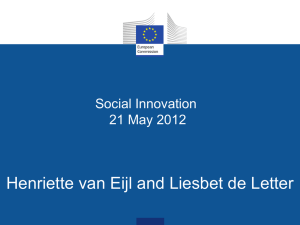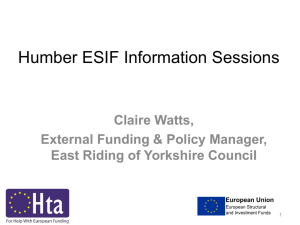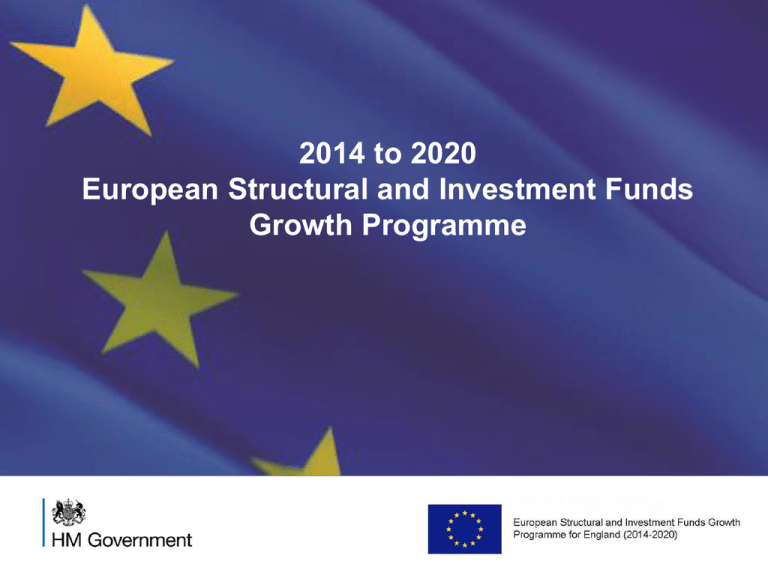
2014 to 2020
European Structural and Investment Funds
Growth Programme
Dr Carol Sweetenham
Head of
ERDF
Department for Communities and Local Government
Delivery: roles and responsibilities
• Delivery will hinge on close working between MA and local partners
coordinated initially by LEPs: therefore essential to define roles and
responsibilities of all parties.
• Partners have been involved in ongoing discussions around roles and
the results of these are reflected in the Partnership Agreement and
Operational Programmes.
• LEPs will coordinate local partners and drive the production and
delivery of a strategy reflecting the wider goals outlined in the areas’
Strategic Economic Plan.
• The Managing Authority is responsible for managing the OP in
accordance with the principles of sound financial management.
ESIF Strategies
(set out local
strategic
priorities)
ERDF / ESF
Operational
Programmes
European Structural & Investment Fund 2014-20
High Level Standard Business Process –
Inception to Funding Agreement
(excluding Opt-Ins, CLLD, Fis, SUD) 11 July 2014
Applicant
Outline Application
against Call
Specification
Full Application
Funding
Agreement
Managing Authority
Local
Implementation
Plan
(Scope and
Timing of Calls
Publish
Call
Call
Specification
LEP Area ESIF Committee
Assess Outline
(Gateway &
Core Selection
Criteria)
Promote
and
Publicise
Call
Assess
Application
against ESIF,
call
specification
and Prioritise
Full Technical
Appraisal
(Core
Selection
Criteria)
Assess Full
application and
review technical
appraisal
against ESIF
and prioritise
Selection
into
Programme
Discuss
and
endorse
selection
Thematic Objectives
1.
Strengthening research, technological development & innovation
2.
Enhancing access to, and use and quality of, ICT
3.
Enhancing the Competitiveness of SMEs
4.
Supporting the shift towards a low carbon economy in all sectors
5.
Promoting climate change adaptation, risk prevention and management
6.
Preserving and Protecting the Environment and promoting Resource Efficiency
7.
Promoting sustainable transport and removing bottlenecks in key network
infrastructures
8.
Promoting Employment and Supporting Labour Mobility
9.
Promoting social inclusion and combating poverty
10. Investing in Education, Skills and Lifelong Learning
11. Enhancing Institutional Capacity and an Efficient Public Administration
Community Led Local Development (CLLD)
•
Both Programmes for England in 2014-20 have built in an element of CLLD.
•
LEP areas have incorporated CLLD projects in their ESIF Strategies. Indicative
LEP ESIF proposals:
c20 LEPs
c69 Local Action Groups
c£124m (of which identified c£63.5m ESF/ £46m ERDF/£14.9m EAFRD)
•
The Commission want a much stronger narrative around the rationale for
CLLD, including evidence of demand/need; an analysis of CLLD compared
against other mainstream funding options available; plus a clearer position on
added value, and how CLLD offers value for money (given costs).
•
Working with LEP areas to build narrative and also consider whether CLLD is
the best route through in all cases.
•
From July onwards more detailed guidance and implementation arrangements
will be developed.
Community Led Local Development (CLLD)
Next steps……
• EU Commission feedback integrated and where possible addressed in drafting of
intervention logic and content of the ESF/ERDF and EAFRD programming
documents (July)
• Agreement of CLLD within Partnership Agreement and Operational Programmes
(last towards end of 2014/Jan 2015)
• Finalisation of ESIF assessment and agreement of CLLD within ESIFs ongoing
(to Jan 2015)
• Launch and operationalisation of CLLD from January 2015
Further guidance to local partners will be issued in the Summer
Cross-Cutting Themes
•
Sustainable development envisages economic growth that is inclusive and
environmentally sound to build shared prosperity, deliver immediate and longterm benefits, and meet the needs of future generations.
•
Equalities: All ESI funds should promote equality in accordance with EU and
domestic legislative and regulatory requirements. The 2010 Equality Act
protects nine characteristics – age, disability, gender reassignment, marital or
civil partnership status, pregnancy and maternity, race, religion and belief, sex
and sexual orientation.
•
The public sector Equality Duty also applies in the delivery of European
funding, and means that delivery of the Programme should consider the
needs of all individuals and have due regard to the need to eliminate
discrimination, advance equality of opportunity, and foster good relations
between different people when carrying out their activities.
Timing
Activity
July
Information to LEPs and partners on:
Specific issues that arise during discussion with the EC on UK Partnership Agreement and Operational
Programmes
End July
Information to LEPs and partners on:
Calls Process - Management of the first round of calls
Implementation Plan
Eligibility Rules
Initial guidance on Financial Instruments
Guidance on next steps in CLLD
Technical Assistance
Performance Management Arrangements
Definition of Outputs
Terms of Reference and establishment of local ESI Fund committees (if finalised)
Local teams work with local ESI Funds Committee on ESI Funds Implementation Plans and developing the
project pipeline
New 2014-20 ESI Funds section of Gov.uk Website goes live with content on:
Business process (Documents produced to date)
Policy papers
Governance
On-line handbook (Information available to date)
GPB Sub-Committees meet to discuss draft Implementation Plans
MA works with Partners to develop CLLD proposals
July / Aug /
Sept
September
From Sept
October
ESF & EAFRD Operational Programmes expected to be adopted
ESF & EAFRD Implementation Plan content agreed by HMG
Information to LEPs and Partners on Application process:
Outline and Full application forms
Application guidance
Appraisal guidance
Training and capacity building for local MA teams, partners and applicants on application process.
October /
November /
December
Designation of the formal Programme Monitoring Committees (PMC) for the ESI
Funds in the Growth Programme. After designation the PMCs will formally
approve(depending on the Fund)
Respective Programme Monitoring Committees (PMC) formally constituted and
approve (depending on the Fund):
Selection Criteria (Structural Funds and EAFRD PMCs)
Sub-committees’ Terms of Reference (Structural Funds and EAFRD PMCs)
Technical Assistance Strategy (Structural Funds PMC)
Selection of criteria for Opt-In Organisations (Structural Funds PMC)
Opt-In organisations apply for funding and MA carries out appraisal
December
January
February
February
Spring 2015
Local ESI Fund Committees
Agree final Implementation Plan
Considers MA Funding Agreement with Opt-In Organisations
ERDF Operational Programme expected to be adopted
ERDF Implementation Plan content agreed by HMG
Calls opened
For operations as specified
For first wave of CLLD activity
For first wave of Opt-in activity
Information to LEPs, Partners and potential applicants on contract management
processes:
Project Initiation Visit
Monitoring and verifications procedures - Claims Checks & On-the-spot visits
Irregularities reporting
On-line Handbook
Structural Funds IT system goes live
First expected investments on the ground, including through Opt-ins
Governance
• Government is aligning the process for implementation of the 20142020 ESI Funds as far as possible, particularly for ESF and ERDF.
• Managing Authorities for individual funds still need to report to the EU
at a national level on each fund and there are therefore 2 separate
Operational Programmes for ESF and ERDF.
• Government established a Growth Programme Board (GPB) to act as
a shadow national Programme Monitoring Committee (PMC) for the
England Growth Programme. Once the Programme moves into an
operational phase the GPB will act as the PMC for both the ERDF and
ESF ESI Funds.
Governance (Sub-committees and EAFRD)
• The GPB/ PMC is chaired by the Managing Authority for the
Programmes. It will be supported by a number of functional and cross
cutting thematic sub-committees (for example on communications,
equalities and sustainability).
• The PMC will be supported by 39 Local Sub-Committees – or [LEP
area] ESIF Committees - one for each Local Enterprise Partnership
area, chaired by Partners. Government will ask Local Enterprise
Partnerships to co-ordinate the Local Sub-Committee and partners in
their area in accordance with the EC Code of Conduct on
Partnership.
• The Rural Development Programme will be overseen by an EAFRD
PMC. The GPB will advise the EAFRD PMC on issues concerning
growth.

